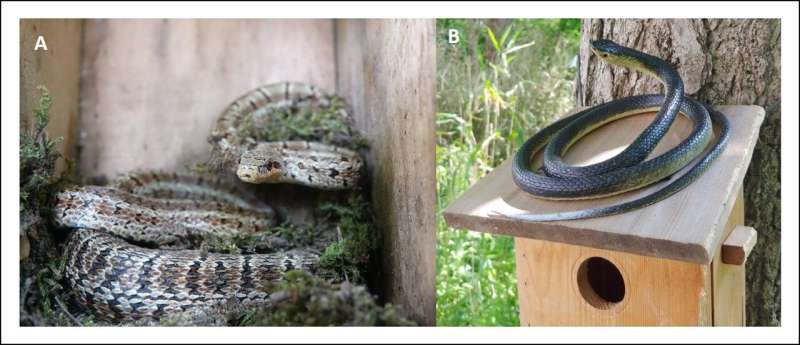What information is coded in bird alarm calls—a new study from Korea

Have you seen small birds nervously jumping up and down the branches and calling at a cat in a park? For a long time, scientists have been interested in what type of information about predators is coded in alarm calls; is it predator's species identity? Or their size? Or how dangerous it is? A recent study published in Ethology provides new discoveries in this field.
The study carried out by researchers of the Laboratory of Behavioral Ecology and Evolution at the Seoul National University (SNU, Korea) and the Laboratory of Integrative Animal Ecology at DGIST (Korea) with a collaboration of the Museum and Institute of Zoology, Polish Academy of Sciences, has focused on the Oriental tit (Parus minor). Oriental tits breed in tree cavities or nest boxes. Therefore, they are protected from predators that cannot squeeze into the nest. However, some predators like snakes can do that. It has already been known that Oriental tits give a special alarm call that sounds like rattling (Audio recording of response to a snake.mp3) when a snake approaches their nest. When nestlings in the nest hear this call, they jump out of the nest. This call is different from a call to a bird predator, like crows, magpies or jays, that cannot enter the nest and tries to capture young birds outside of their nests.
"As snakes belong to the type of predators that enter nests, we thought that the rattling call carries information about the predator's ability to enter the nest," says Ph.D. candidate Jungmoon Ha. If the rattling call says "be aware of a predator that can enter the nest," then this call should be also given to other predators who can enter the nest, such as chipmunks. In the study area, chipmunks are quite common and are known to destroy the nests of tits just like the snakes do. Researchers recorded the alarm calls of Oriental tit parents to a snake and to a chipmunk put on top of the nest box, and compared them to the alarm calls toward a Eurasian jay model put next to the nest box. They found that the calls are different from each other; the alarm calls were different even though both the snake and chipmunk can enter the nest (Audio recording of response to a chipmunk.mp3). "This means that the rattling call does not signal the predator's ability to enter the nest, but rather has a very specific meaning like 'be aware of a snake,'" concludes Prof. Piotr Jablonski (Laboratory of Behavioral Ecology and Evolution, SNU), who has studied anti-predatory adaptations in animals for years. It also suggests that the calls towards a chipmunk may mean 'be aware of a chipmunk' or 'be aware of a small mammal,' but certainly it is different from the calls towards a jay that may mean 'be aware of a bird.'"
"Then we checked if nestlings jump out of the nest only in response to the playback of 'snake call' or also in response to the playback of 'chipmunk call,'" comments Mr. Ha. The nestlings jumped out only in response to 'snake call,' as has already been known. Why didn't they jump out in response to 'chipmunk call' even though a chipmunk may enter the nest and eat them? "We suspect that snakes eat young birds in the nest cavities much more often than chipmunks do, and therefore natural selection has produced this specific call against snakes and the specific reaction of young birds to it," explains Prof Sang-im Lee (Laboratory of integrative Animal Ecology, DGIST), who has been studying the family life of birds. The researchers suggested that, like in humans and primates, there is something special about the fear of snakes that results in the special 'be aware of snakes' calls in birds.
More information: Jungmoon Ha et al, Experimental study of alarm calls of the oriental tit ( Parus minor ) toward different predators and reactions they induce in nestlings, Ethology (2020). DOI: 10.1111/eth.13012
Provided by Seoul National University




















